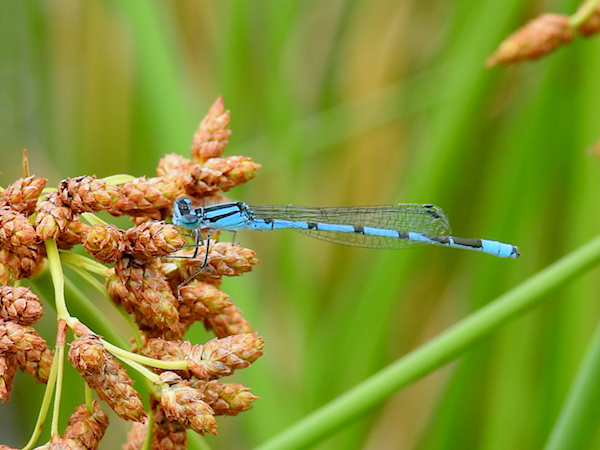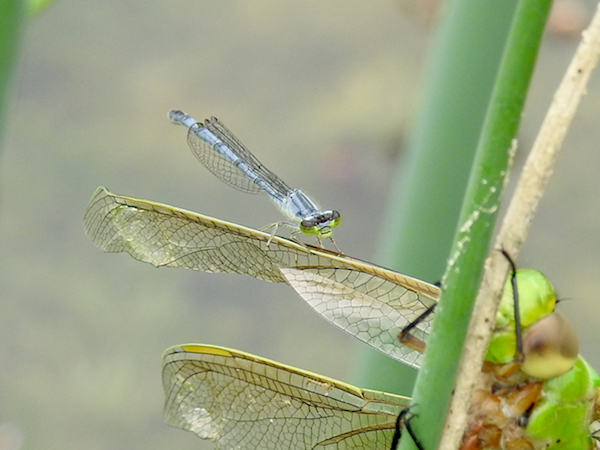
July is usually the start of the best three months of ode-hunting at Andrew Haydon Park. Although I often visit the park in the spring and fall for birds, my time here in the summer is devoted to dragonflies. This park is reliable for Halloween Pennants, Blue Dashers, Eastern Pondhawks, Common Green Darners, Prince Baskettails, and the usual King Skimmers, and I’ve had Cobra Clubtail and Elusive Clubtail here as well. I visited on July 29th with the hope of seeing another Cobra Clubtail, as it was on July 21, 2019 that I saw one fly into a tree on a windy day, eating what looked to be a male Orange Bluet. Though I’ve looked for both species here in July in subsequent years, I only had luck with one female Orange Bluet on July 24, 2021.
It was cloudy when I arrived, and though I kept hoping the sun would break through, it never did. It was also much cooler than I’d hoped, only about 13°C, and although it wasn’t supposed to be as hot as yesterday’s 28°C, I hoped it would at least get up to 20°C. I started with a walk along the eastern creek, noticing a few Eastern Forktails in the reeds including a few females that looked very dark. Some Sedge Sprites were present as well. I found a freshly emerged Autumn Meadowhawk perching in a shrub and stopped to take its photo.

Then a long, dark, blue-tipped damselfly with a yellow or light green face and thorax flew by and landed on a leaf above my head. It looked too pale for an Eastern Forktail, so I took a few photos. It looked like it might be a Vesper Bluet, though I’d never heard of any being found at Andrew Haydon Park before. I tried to get a closer look but it flew across the stream where I lost it in the bushes.
Eastern Forktails, however, were numerous and willing to sit still for a photo. This is an immature female, which is orange at the top and black down the abdomen from segments 4 through 9 – you can see there is a tiny bit of orange on the last segment, though this colouration is barely noticeable in the field.

Although I scanned all the forktails in the sedges, I only found one Fragile Forktail, a male. In Ottawa they are considered uncommon, and while they are definitely outnumbered by the Eastern Forktails, I usually see one or two in most places I visit.

I headed out along the north (river) side of the ponds, searching the emergent vegetation for Halloween Pennants, Blue Dashers, and other skimmers. Some blue-type bluets were present in the vegetation emerging from the water; I couldn’t catch them as they were too far out for my net. Other smaller bluets were in the reeds right along the shore, and I managed to catch and identify three Marsh Bluets. Marsh Bluets are often abundant where they are present, and the males are among the bluest of the bluets. The black portion of the first few segments is limited to a small ring on each segment; the amount of black then increases on segments 6 and 7 with segment 7 almost completely black and segment 6 about half, or slightly more than half black.

The Marsh Bluets differed in appearance from the slightly larger bluets further out in the water. It took me a while, but I finally managed to capture two and identify them as Tule Bluets. Both had abdomens that appeared more black than blue, thus appearing darker than the Marsh Bluets in the same area. Identification was confirmed by the shape of the upper claspers, which appeared rounded rather than angled like a Familiar Bluet, another species I’ve found often along the Ottawa River.

Then I saw a freshly emerged teneral Common Green Darner in the reeds at the edge of the water. At first I was thrilled to spot it, as mature darners rarely land long enough for a photo, but then I realized that the forewings were both crinkled, likely becoming damaged during or immediately after emergence from the larval shell. While the dragonfly was able to spread its wings in the familiar airplane position, it wouldn’t be able to fly.

Then I noticed something else: a tiny female Eastern Forktail was perching on top of the damaged wing! Odes are wary, cautious creatures, and quick to sense any dangers in their vicinity. As soon as they become aware of any threat in their environment they shoot off into the sky. It was interesting to see that this forktail was completely unaware of the deadly predator it was perching on; if the darner had been able to fly, it would have happily caught and snacked on the forktail!

After taking a few photos of this unusual odonate duo I continued making my way around the ponds. As I cut across the lawn, I flushed up at least ten fresh teneral Autumn Meadowhawks resting in the grass – it looks like a large number emerged overnight. I didn’t see any Blue Dashers, but one Halloween Pennant was also resting on a weed sticking out of the lawn. I didn’t notice it until it flushed and flew to a spot overlooking the water.
I headed over to the waterfall, as I’ve seen dragonflies patrolling the creek here in the past, particularly Aeshnid (mosaic) darners. There were no dragonflies here, but more forktails resting in the vegetation surrounding the creek flushed as I approached the water. Then another long, slender damselfly that looked yellowish at the front emerged from the grass at my feet. It quickly flew across the creek where I lost it.
I was intrigued by these possible Vesper Bluets, and frustrated that I couldn’t get a decent photo of one perching. I headed back to the eastern pond, following the shoreline of the ponds and carefully scanning the emergent vegetation and lilypads close to the shore. I saw more blue bluets….and then I spotted one that wasn’t blue. Its head and thorax were yellow, and its abdomen was black with a blue tip. Finally, a confirmed male Vesper Bluet!

The Vesper Bluet is named for its crepuscular habits – it is most active in the evening, which is when the Roman Catholic prayer of thanksgiving and praise known as Vespers is held (“vesper” is Latin for “evening”). This slender damselfly inhabits lakes, ponds, and slow-moving rivers with floating vegetation and wooded areas nearby. These damselflies spend most of the early part of the day in the vegetation and tree tops; then, in the late afternoon, males settle onto lilypads where they seek out females. Mating and egg-laying then continue until after dark, later than most other damselflies are active. Females are not as slender as males, and are greenish-yellow above; they are often confused with female Orange Bluets, another type of bluet that is not blue in colour which is found in similar habitats.
I was thrilled to confirm this species here at Andrew Haydon Park, as I’ve never seen one in Ottawa outside of Petrie Island. This was at least the third individual I saw, and there may have been more in the vegetation given the early hour of the day. I’ll definitely have to return on a warmer, sunnier day to see if I can find them on the lilypads with the equally colourful Orange Bluets, which also spend the early part of the day in the vegetation and make their way to the water later in the afternoon.
The last interesting damselfly of the day was not a bluet, nor was it particularly colourful. The Spotted Spreadwing may very well be our darkest damselfly, and is the latest-flying damselfly in our region. The short paraprocts are visible in this photo, and are distinctive among spreadwings.

Despite the thick, gray wall of clouds covering the sky and cool temperature there was more to see at Andrew Haydon Park than I had initially hoped. I ended up with ten ode species, a respectful tally for the early hour and sub-optimal weather. Although I was happy to catch and identify the Marsh and Tule Bluets, the best find was definitely the Vesper Bluet, a lovely species I didn’t need to catch to confirm due to its unique colouration. It was wonderful to see this regionally local bluet of a different colour so close to home, and I’ll be sure to visit on a nicer day to see how many I can find!